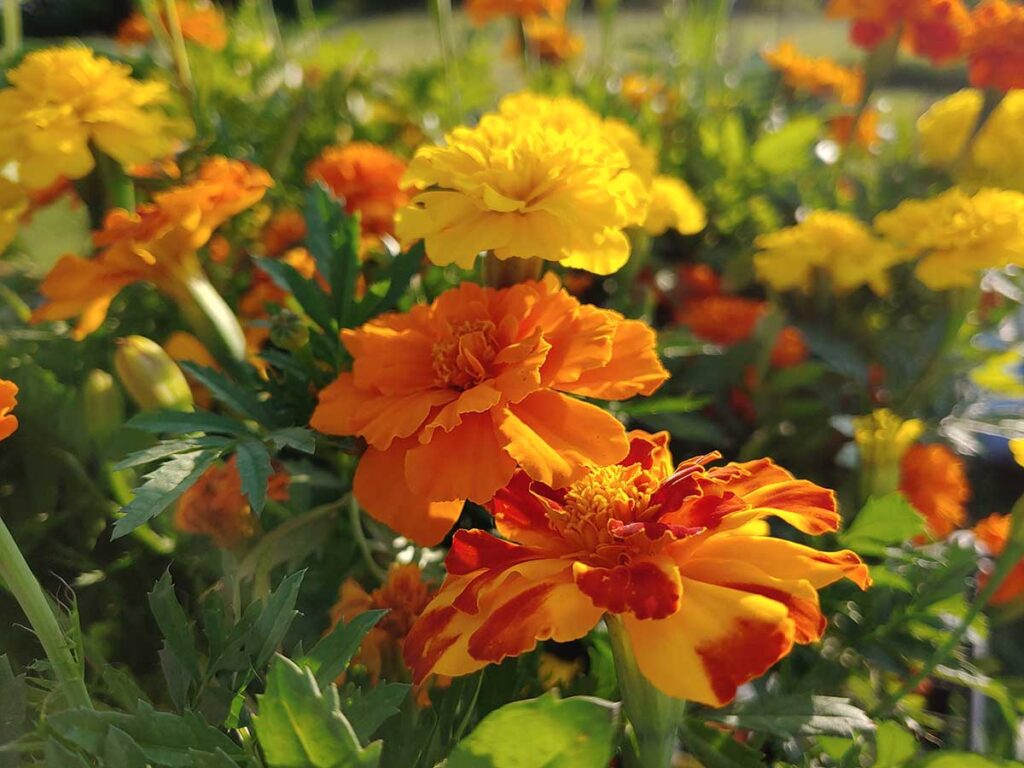Marigold, as a common name for a gold flower, is found representing different flowers in different countries and for different cultures. In the United States, marigold refers to Tagetes which falls within the family Asteraceae. This lovely plant family includes asters, daisies, lettuce, mums, sage, sunflowers, and zinnias. Good company with which to be associated. Marigolds, which are delightfully versatile in the landscape, are oft times maligned as a too common, too easy annual. Yes, they are common. Yes they are easy. These plants are troopers and perform wonderfully when treated with a modicum of care.
Most of the readily available and plentiful marigold cultivars for the annual garden fall somewhere within three species – Tagetes erecta, Tagetes patula, and the less common, but certainly lovely, Tagetes tenufolia. All Tagetes bring a vibrancy to the garden color palette. Their distinctive and identifiable scents will, to one, be pleasant and to others, much too pungent. Other species to consider planting include Tagetes lucida and Tagetes minuta, which are planted and grown for plant health and medicinal purposes as well as for use in cooking. T. lucida is quite a pretty, mounding plant with numerous small flowers. T. minuta is a tall, strong plant found mainly in the Southeast United States, Mexico, and South America.
All marigolds will perform best in full sun, tolerating a couple hours of shade per day. They are not a fussy plant when it comes to soil and pH levels. Like most flowering plants, marigolds will benefit from a couple of light fertilizer applications during the growing season. Go easy on the nitrogen or the foliage will be grand, the flowers not so much. As the foliage is susceptible to mildew, water at the ground level, especially during periods of high humidity. Marigolds grown in areas with high humidity will physically melt out during those periods of intense air moisture. If high humidity starts taking out the marigolds, one approach is to cut your losses, remove the plants and replant. If there is eight weeks of growing season left, drop some seed into the ground and enjoy another round of flowers. Another approach is to trim back the dead portions and ride it out. Deadheading (removal of spent flower heads) is necessary. Failure to do so will result in decreased flowering and increased disease issues.
Companion planting systems benefit from strongly scented and brightly colored plants to mask the existence of damage susceptible edibles. Tagetes serve as able garden companions. While there are numerous claims about the wonderous properties found in Tagetes, science has proven only a handful. Of those, the chemical properties contained in root systems appears to be the most beneficial for the average gardener. Specifically, the roots of Tagetesminuta contain alpha-terthienyl, which can interrupt the life cycle of soil borne nematodes. To be effective at interrupting nematode life cycles, plant, grow out, and remove marigolds before planting the target crop in ground. The target crop must be planted exactly where the marigolds grew to reap the benefits. Marigolds also do a great job of inviting beneficial insects into the garden to ravage those pesky crop-eating insects.
Bonus? Many marigold flower petals may be eaten. Discretion is recommended when choosing which to consume as individual flower petal flavor varies as do consumption preferences.

